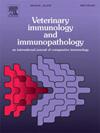Neonatal Fc receptor participates in endocytosis of Fc fusion protein in vivo and in vitro
IF 1.4
3区 农林科学
Q4 IMMUNOLOGY
引用次数: 0
Abstract
The neonatal Fc receptor (FcRn) binds to IgG CH2 and CH3 domains (the Fc segment), triggering transendocytosis. Therefore, FcRn transports biological agents across the mucosal barrier. Mucosal administration provides less stimulation to the body than other methods. However, whether FcRn is an effective carrier for antigens across bovine respiratory epithelial cells is unknown. Here, an antigen was fused with the Fc fragment and transferred through the mucosal barrier to antigen-presenting cells via active transport mediated by FcRn. We established a model of FcRn-mediated recombinant IgG Fc protein expression in bovine embryonic tracheal epithelial cells. Western blotting showed that SPA inhibited the relative transport amount of FcRn-mediated IgG Fc fusion protein. Fc fusion protein positively correlated with protein concentration and action time, with the maximum level reached at 1.4 mg/mL (protein concentration) and 18 h (action time). An FcRn-mediated transport model of the IgG Fc recombinant protein in guinea pig lungs was established, and the amount of protein transported at different time points was measured using immunohistochemistry. FcRn mediates vaccine antigen delivery through the mucosal barrier to activate immune cells in the lamina propria, laying a theoretical foundation for the clinical application of nasal mucosal immune vaccines.
新生儿 Fc 受体参与体内和体外 Fc 融合蛋白的内吞作用
新生儿Fc受体(FcRn)结合IgG CH2和CH3结构域(Fc片段),触发转内吞作用。因此,FcRn通过粘膜屏障运输生物制剂。粘膜给药比其他方法对身体的刺激少。然而,FcRn是否是牛呼吸道上皮细胞抗原的有效载体尚不清楚。在这里,抗原与Fc片段融合,并通过FcRn介导的主动运输通过粘膜屏障转移到抗原呈递细胞。建立了fcrn介导的重组IgG Fc蛋白在牛胚胎气管上皮细胞中的表达模型。Western blotting结果显示,SPA抑制了fcrn介导的IgG Fc融合蛋白的相对转运量。Fc融合蛋白与蛋白浓度和作用时间呈正相关,最大表达量为1.4 mg/mL(蛋白浓度)和18 h(作用时间)。建立fcrn介导的IgG Fc重组蛋白在豚鼠肺中的转运模型,采用免疫组化方法测定不同时间点的转运蛋白量。FcRn介导疫苗抗原通过粘膜屏障传递,激活固有层免疫细胞,为鼻黏膜免疫疫苗的临床应用奠定理论基础。
本文章由计算机程序翻译,如有差异,请以英文原文为准。
求助全文
约1分钟内获得全文
求助全文
来源期刊
CiteScore
3.40
自引率
5.60%
发文量
79
审稿时长
70 days
期刊介绍:
The journal reports basic, comparative and clinical immunology as they pertain to the animal species designated here: livestock, poultry, and fish species that are major food animals and companion animals such as cats, dogs, horses and camels, and wildlife species that act as reservoirs for food, companion or human infectious diseases, or as models for human disease.
Rodent models of infectious diseases that are of importance in the animal species indicated above,when the disease requires a level of containment that is not readily available for larger animal experimentation (ABSL3), will be considered. Papers on rabbits, lizards, guinea pigs, badgers, armadillos, elephants, antelope, and buffalo will be reviewed if the research advances our fundamental understanding of immunology, or if they act as a reservoir of infectious disease for the primary animal species designated above, or for humans. Manuscripts employing other species will be reviewed if justified as fitting into the categories above.
The following topics are appropriate: biology of cells and mechanisms of the immune system, immunochemistry, immunodeficiencies, immunodiagnosis, immunogenetics, immunopathology, immunology of infectious disease and tumors, immunoprophylaxis including vaccine development and delivery, immunological aspects of pregnancy including passive immunity, autoimmuity, neuroimmunology, and transplanatation immunology. Manuscripts that describe new genes and development of tools such as monoclonal antibodies are also of interest when part of a larger biological study. Studies employing extracts or constituents (plant extracts, feed additives or microbiome) must be sufficiently defined to be reproduced in other laboratories and also provide evidence for possible mechanisms and not simply show an effect on the immune system.

 求助内容:
求助内容: 应助结果提醒方式:
应助结果提醒方式:


